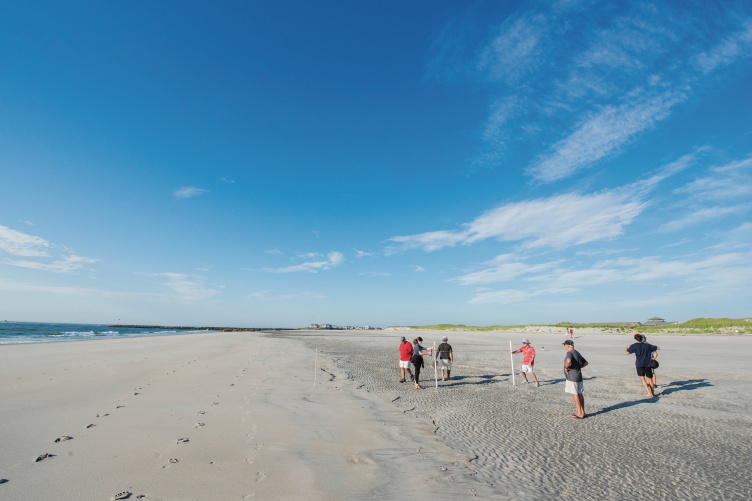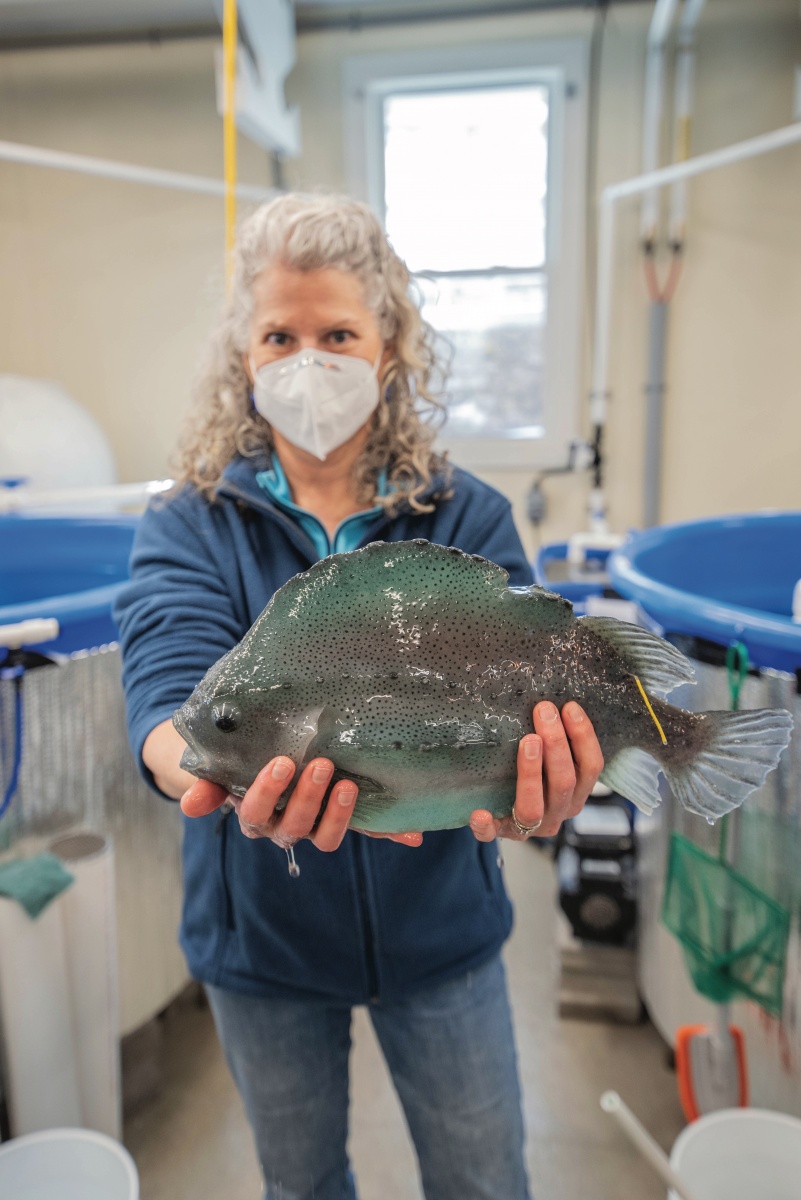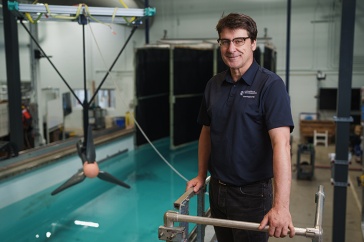
When it comes to the economy, the ocean is a major player — from tourism to energy, seafood to shipping, the world’s marine-related assets tally up to trillions of dollars. But our oceans and coastlines are facing unprecedented pressures. Confronted with this reality, a new concept has emerged that considers both the economic benefits and the long-term sustainability of marine resources across all sectors: The blue economy.
The term is more than just a buzzword; it’s helping researchers think more broadly about how they can connect their work to new partners. From ocean acoustics to environmental DNA analyses, the breadth of blue economy research at UNH is wide-ranging and its momentum is building.

“The blue economy characterizes the critical nexus between ocean conservation and economics, because we can’t continue to draw from the ocean’s resources if we don’t conserve them,” says Diane Foster, director for the UNH School of Marine Science and Ocean Engineering (SMSOE). She is deeply involved in building partnerships between UNH and leaders in industry, federal government and nongovernmental organizations under this blue economy umbrella.
Industry-science partnerships are a critical component of the blue economy, and nowhere is that more evident than at the UNH Center for Coastal and Ocean Mapping (CCOM), a hub of innovative software and hardware development and cutting-edge expertise in seafloor mapping. CCOM researchers have cultivated those collaborations since the center’s inception in 2000 via its industry consortium, which regularly brings together scientists and developers who learn from one another and work together to test and improve the next generation of ocean mapping technology.
“Our industrial consortium has been one of the highlights of the program,” says CCOM director Larry Mayer, who is also a professor of Earth sciences. “Our researchers and students are exposed to real-world problems while gaining a better understanding of how the commercial sector works, and hopefully our partners have benefited from the tools we have developed and from our interactions with them.”

Powering the Blue Economy
The tidal currents that flow beneath the Memorial Bridge in Portsmouth, N.H., are deceptively fast — peak flows can reach almost six knots, or three meters per second. The fact that those conditions can be found not far from UNH’s Durham campus is a stroke of luck for researchers like Martin Wosnik, UNH professor of ocean engineering and director for the new Atlantic Marine Energy Center (AMEC) — a $9.7 million project funded by the Department of Energy (DOE) that partners with several other East Coast universities and DOE National Laboratories.
“We’re out there testing tidal energy converters in a highly energetic environment and freezing cold conditions, and then a hot tea or coffee is just a quick boat ride away,” he says, smiling.
Wosnik and his colleagues are quite literally powering the blue economy — they’ve been developing and testing tidal and wave energy devices in UNH’s facilities and N.H. waters for many years. In partnership with industry and National Laboratories collaborators, they’re currently testing the performance of cutting-edge marine energy devices, developing a wave-energy-powered water pump, and designing, building and testing a reference model of a tidal turbine. This publicly available, open-source design will allow them to better evaluate the turbine’s performance and provide a benchmark to help turbine developers evolve their designs. In between, they’re conducting environmental impact studies to ensure their marine energy technologies do the least harm possible to their surroundings.
In his role as AMEC Director, Wosnik plans to expand upon these projects and delve into new technologies related to renewable energy. He’s upbeat about the potential for progress, but also quick to point out that it won’t be an easy path.
“The energy transition away from fossil fuels and toward more sustainable solutions is a massive undertaking and will require all hands on deck,” he says. “But this is our chance to help harness the abundant energy in the ocean and find solutions that are better for future generations.”
Sustainable Seafood, Sustaining the Sea
Michael Chambers, research professor with SMSOE, knows a thing or two about growing fish —his aquaculture collaborations with local fishers and chefs have put New Hampshire on the culinary map for oysters, steelhead trout and kelp. Chambers and his colleagues across New England now find themselves pivoting hard toward whale-friendly aquaculture gear to decrease potential entanglement of highly endangered right whales that travel through the Gulf of Maine.
His team is working with a new type of line made from fiberglass rebar that’s currently being evaluated at a kelp farm in Maine. “It’s like dry spaghetti, so when it bends, it eventually breaks,” Chambers says, “so that means if a whale swims through the farm, there would be less opportunity for the whale to entangle in the stiff lines. Sure, it would break the farm up, but it wouldn’t affect the whale — it would just keep swimming.”
Chambers is part of the new UNH Sustainable Seafood Center, a joint venture between SMSOE and the College of Engineering and Physical Sciences that operates at the intersection of food security, climate change adaptation and ecological protection. Education will be a major component for the new center, and Chambers is working directly with communities throughout the U.S. to help them build and sustain their own version of UNH’s AquaFort — a floating platform that grows fish, kelp and shellfish alongside one another, providing food with virtually no impact to the marine environment.

Also at the Sustainable Seafood Center, Elizabeth Fairchild, a research associate professor of biological sciences, conducts research with lumpfish. These charismatic creatures serve as a cleaner fish in Europe and Canada, where they eat sea lice off the salmon-like steelhead trout raised in aquaculture pens — a practice widely considered to be more environmentally friendly than treating fish with chemicals to fend off the pests. She has been working with regional colleagues to establish a lumpfish industry in the U.S. and help aquaculturists navigate the onerous permitting process that will enable them to utilize the cleaner fish species in their pens.
“I’m excited for the Sustainable Seafood Center to grow here at UNH,” says Fairchild. “We have a long history of cutting-edge applied research in the marine environment — we’re good at uniting various groups, like engineers, aquaculturists and fisheries biologists who are working toward a common goal.”
Resilient Coastlines and the Assets they Protect
Despite New Hampshire’s modest length of coastline, it boasts a thriving ocean-based tourism and recreation sector. However, more intense storms, rising sea levels and frequent flooding are threatening the businesses and infrastructure that underpin those parts of the economy.
Alyson Eberhardt, a coastal ecosystem specialist with New Hampshire Sea Grant and UNH Cooperative Extension, has been working to improve the resilience of the New Hampshire seacoast and offer better ecosystem-based protection in the face of those threats.
Along with her colleagues at the UNH Coastal Habitat Restoration Team, she regularly engages with volunteers, coastal homeowners and students to plant native grasses that trap sand and build up natural dunes that serve as the frontline of protection from storms that ravage the coast. She’s involved in a new $3 million project funded by the National Fish and Wildlife Foundation that is aimed at additional protection and restoration for dunes and salt marshes.
Eberhardt has also spent the past six years working with volunteers to learn about height changes on the state’s beaches as the sand moves with the tides. The beach profile data they’ve collected is forming a clearer picture of which beaches would benefit from additional sand nourishment and which ones are doing just fine on their own; this information is critical for local decision-makers who want to ensure there’s space for beachgoers to enjoy the water’s edge.
“The stressors on our coastal and marine systems are increasing, and it’s scary to think about the loss of our marshes and dune systems,” Eberhardt says, “but there’s more awareness and a growing interest in protecting those ecosystems, coupled with a wave of financial support and resources coming in. Ultimately, I’m hopeful that there’s some awesome potential to make really big, positive changes going forward.”

-
Written By:
Rebecca Irelan | Institute for the Study of Earth, Oceans, and Space | rebecca.irelan@unh.edu | 603-862-0990

















































